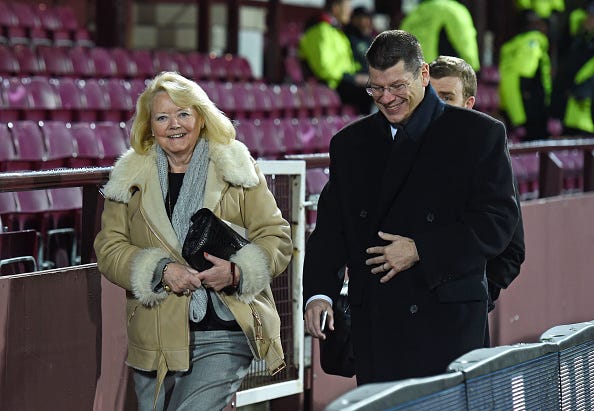RECONSTRUCTION #1 'What fans say they want is not the same as what fans will pay for'
💥 SPFL chief executive NEIL DONCASTER speaks EXCLUSIVELY to Nutmeg FC 💥
Award-winning sportswriter Stephen McGowan kicks off his new monthly investigations series with league reconstruction - and a revealing chat with the SPFL’s chief executive
🗣️ Tomorrow: Part II - A View From … the Player, the Manager, the Chairman, the Fan
🗣️ Wednesday: Part III - Stephen McGowan’s analysis of the report by the Competitions Working Group
Parts two and three are for paid subscribers only
Been waiting for right moment to support our indie journalism? This is it…
By Stephen McGowan
On a Friday morning in an office on the sixth floor of Scotland’s National Stadium, Neil Doncaster is contemplating the impossibility of a world where the grass is greener than the Hampden pitch. An unattainable utopia where everyone agrees on the size of the league and reconstruction debates become a thing of the past.
“Look, the reality is that there’s no such thing as a perfect format,” states the chief executive of the Scottish Professional Football League. “The only truism is that people always believe that whatever you have at any moment in time, there’s something better out there.
“What there is in reality is a series of compromises that give you the best possible format at any point in time.”
A brief history of reconstruction in Scottish football would read as follows…
Pre-1975, there were two divisions of 18 and 19 teams. Celtic’s surge to nine-in-a-row triggered a bout of collective boredom which persuaded Scottish league clubs to vote for three leagues of 10-14-14 in 1975.
They bumped up the number of teams in the top flight in 1986 and added a fourth tier, incorporating more senior clubs, in 1994.
Celtic, Rangers and eight others broke away from the now defunct Scottish Football League to form the Scottish Premier League (SPL) in 1998.
In order to secure the agreement of the teams left behind, the SPL reluctantly agreed to expand the competition to 12 teams by 2000.
A split was introduced to prevent players being flogged for 44 games a season. After the 33rd round of fixtures the top six split from the bottom six and the teams would play their closest rivals once more to decide the destination of the title, European places and relegation. An imperfect system, the 12-team split is still in place a quarter of a century later on the basis that it works well for clubs. Less so for supporters weary of watching teams play each other four times a season.
At the beginning of April, a breaking news story in the Herald concerning fresh reconstruction proposals caused quite the stir. The SPFL’s Competitions Working Group had begun devising potential changes to the league structure in order to ease fixture congestion caused by the expansion of UEFA club competitions.
Securing a softer landing for clubs like Brechin City and Cowdenbeath dropping out of the senior set-up to the largely unfunded Lowland and Highland Leagues was also part of their remit.
While supporters clearly wanted 14 or 16 teams, a return to a 10-team Premiership with a drop in fixtures from 38 to 36 became another of the options under active consideration.
By the time the SFA’s Pyramid Working Group — comprising representatives of all the major leagues — had been updated on the plans, a popular revolt was taking root. On social media, the reaction to a 10-team league brought anger and revulsion.
Three of the teams in the Scottish Premiership — Hearts, Motherwell and St Mirren — are now fan owned. With an 11-1 vote required to enact any major change to the Premiership, the 10 was effectively dead.
Tomorrow, the Competitions Working Group will report back to clubs on their findings and that might be the easy part. Finding a solution that Scotland’s 42 senior clubs can agree on makes peace in the Middle East seem like an attainable goal.
“Ultimately there is a bit of a surge in interest in there being reconstruction,” Doncaster acknowledges. “I think it’s right that we respond to that. And we will have a dialogue with clubs.
“There’s no doubt from a reconstruction point of view, there are a number of things that have changed recently that drive that debate. And one of those is the intense level of congestion that we have this year; unprecedented congestion, which has been caused by the new UEFA club competition formats, the league phases, has increased the number of European match days and therefore decreased the amount of slots that we have available to play our matches.
UEFA competitions have caused congestion which is on the point of being unmanageable
“We are in serious danger of having to make clubs play four games in a week. That’s where we are now, unless we act. UEFA club competition formats have now caused congestion within the top tier in this country which is on the point of being unmanageable.”
At this point, Nutmeg’s ears prick up. Last season, UEFA changed the format of the Champions and Europa Leagues from the old four-team groups to single tables of 36. At a stroke, the number of games Celtic and Rangers played in Europe increased from six to eight.
Good for the bank balance of Scotland’s big two — and the solidarity payments paid to domestic league rivals — but more fixtures meant less wriggle room for the men charged with managing Scotland’s fixture calendar. Even the abolition of the January winter break failed to make a significant difference.
“Basically, with the expansion of the UEFA competitions, you add four days to the calendar,” states the SPFL’s chief operating officer Calum Beattie.
“You’ve got to find four days to get rid of the winter break. Abolishing that was the ace we had up our sleeve.
“We’ve now got no more aces up our sleeve. And you can see last year with the Dundee v Rangers game close to the split just how difficult it can get.”

The topic of league reconstruction was last discussed in April 2020, when Covid-19 forced a premature end to the league season. Lobbing a bone towards clubs adversely affected, the SPFL committed to a consultation over an expanded Premiership in time for the new campaign. Hearts chair Ann Budge and SFA vice president Les Gray spearheaded a reconstruction task force and it ended, a month later, with Budge submitting a proposal to the SPFL board for three leagues of 14 — the Premiership splitting after two rounds of fixtures into a top six and a bottom eight.
The appeal to Hearts was obvious, because they were facing premature relegation as a consequence of a season curtailed by a global pandemic. However, the blueprint also drew unexpected support from supporters of teams with no skin in the game. It made no difference to the final outcome. The Budge plan failed to gain the necessary votes.
The Scottish Football Supporters Association boasts a membership of around 80,000 — some more active than others. And an SFSA survey of 3,250 fans found that 84% favoured an end to teams playing the same opposition four times a season.
“One of the problems that we have in this debate is that what fans say they want is not the same as what fans will pay for a ticket to go to,” adds Doncaster.
“What we know drives bigger attendances is tense, competitive, meaningful, exciting, dramatic matches where there’s something to play for. You get those with smaller leagues, not bigger leagues. So, the bigger the league you have, the more meaningless matches it creates.
“We’ve had in this country very big leagues. Not in recent memory, but if you talk to folk who do have memory of those times, they will tell you that towards the end of the season, there was absolutely nothing to play for. You know, lots of mid-table, mediocre matches.”

At this point, Doncaster reaches over his shoulder to pull a sheet of A4 paper from his desk. Listing the number of teams in every one of Europe’s 56 leagues, from Albania all the way down to Wales, the size of the top flights invariably correspond to the size of the nation.
Larger nations with larger populations comfortably sustain more teams. England, Italy and Spain have 20 in the top flight, Turkey has 19 and Germany, France and Poland 18.
Smaller countries with populations similar to Scotland — think Croatia, Denmark, Ireland, Slovenia and Slovakia — tend to stick with 10 or 12 teams. More jeopardy means more meaningful games and, most important of all, fewer mouths to feed.
“I think there’s a number of misapprehensions and misunderstandings about league sizes generally,” says Doncaster. “So, I think there’s a perception that bigger leagues are more common than smaller leagues. The most popular league size for small leagues is a 10-team league playing twice home and twice away.”
While any change to the Premiership grabs the headlines, there’s another issue lower down the pyramid. Since the creation of the pyramid play-offs in 2013, five ‘legacy’ SPFL clubs — Albion Rovers, Berwick Rangers, Brechin City, Cowdenbeath and East Stirling — have been relegated to the Highland or Lowland Leagues. None of them have returned.
“They’re being relegated into a league where there is precious little money, and little — if any — central distributions. And I think we have a responsibility to those clubs and to current clubs in William Hill League Two, who may be facing the spectre of relegation, to look at that. The congestion and the consequences of the pyramid are two real drivers for another look at the leagues.”
While supporters want to fire up the Flux Capacitor and go back to the era of flared trousers, pirate radio and Marc Bolan, a 16-team top flight never seems to gain much traction. Together with a return to a 10-team league, it seems most likely to be discounted as a serious option by the Competitions Working Group.
“In terms of our broadcast contract, for example — which underpins the vast majority of our revenues — that would have a dramatically negative effect.”
Supporters point to a Sky television deal dwarfed by the sums on offer elsewhere and direct their anger and frustration at the man who acts as a human shield for the clubs who actually make the unpopular decisions.
“I think when you’re at a league, you work for a league, you recognise that your ability to impose solutions is virtually zero. And that’s the way it should be.
“We’re there to govern, not to rule. It’s for the leagues, it’s for the clubs to decide what structure they wish to play — and it’s for the clubs to decide what is the fairest way of distributing the money that the league generates. The decision is now in their hands.”



